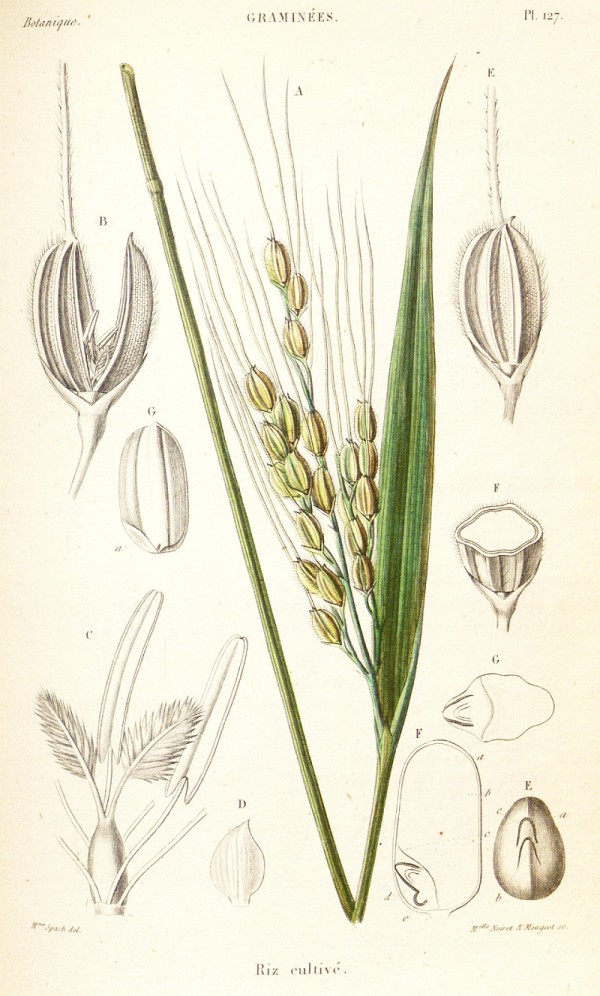Dies ist eine alte Version des Dokuments!
Oryza sativa L. - Poaceae - rice, Reis
Annual, aquatic plant, up to 1.5m tall, cultivated, mainly in flooded fields; culms erect; leaf sheaths slightly inflated below, upper sheaths tight, glabrous, auricles falcate, ciliate; panicle up to 30 cm, nodding at maturity; spikelets oblong to oblong-lanceolate, 7-10mm, persistent; sterile lemmas lanceolate, 1.5-4mm; fertile lemma papillose, spinulose; anthers 1-3mm; caryopsis ovate or elliptic to cylindrical, 5-7 mm, whitish yellow to brown or blackish.
„This is the staple cereal rice, widely cultivated in tropical and warm-temperate parts of the world, and with many different cultivated races.“
http://www.efloras.org/florataxon.aspx?flora_id=2&taxon_id=200025789
„4-Vinylphenol was the main component in the steam volatile concentrate of rice bran, having a characteristic unpleasant odor.“
[Fujimaki, Masao, Takashi Tsugita, and Tadao Kurata. „Fractionation and identification of volatile acids and phenols in the steam distillate of rice bran.“ Agricultural and Biological Chemistry 41.9 (1977): 1721-1725]
From the concentration range of 2-acetyl-1-pyrroline (odor descriptor: popcorn-like) in steam volatile oils of 10 different varieties of rice, the amount present in cooked rice was calculated: Between 6 ppb for Calrose rice and 90 ppb for Malagkit Sungsong.
[Buttery, Ron G., et al. „Cooked rice aroma and 2-acetyl-1-pyrroline.“ Journal of agricultural and food chemistry 31.4 (1983): 823-826]
„… the probable major contributors to the Californian long-grain cooked rice odor included 2-acetyl-1-pyrroline, (E,E)-2,4-decadienal, nonanal, hexanal, (E)-2-nonenal, octanal, decanal, 4-vinylguaiacol, and 4-vinylphenol.“
[Buttery, Ron G., Jean G. Turnbaugh, and Louisa C. Ling. „Contribution of volatiles to rice aroma.“ Journal of Agricultural and Food Chemistry 36.5 (1988): 1006-1009]
„The flavour or fragrance of basmati and jasmine rice is associated with the presence of 2-acetyl-1-pyrroline. A recessive gene (fgr) on chromosome 8 of rice has been linked to this important trait. Here, we show that a gene with homology to the gene that encodes betaine aldehyde dehydrogenase (BAD) has significant polymorphisms in the coding region of fragrant genotypes relative to non-fragrant genotypes. The accumulation of 2-acetyl-1-pyrroline in fragrant rice genotypes may be explained by the presence of mutations resulting in a loss of function of the fgr gene product. The allele in fragrant genotypes has a mutation introducing a stop codon upstream of key amino acid sequences conserved in other BADs. The fgr gene corresponds to the gene encoding BAD2 in rice, while BAD1 is encoded by a gene on chromosome 4. BAD has been linked to stress tolerance in plants. However, the apparent loss of function of BAD2 does not seem to limit the growth of fragrant rice genotypes. Fragrance in domesticated rice has apparently originated from a common ancestor and may have evolved in a genetically isolated population, or may be the outcome of a separate domestication event. This is an example of effective human selection for a recessive trait during domestication.“
[The gene for fragrance in rice., Bradbury, L.M., Fitzgerald, T.L., Henry, R.J., Jin, Q., Waters, D.L., Plant Biotechnology Journal, Vol.3(3), 2005, 363-370]
„The aroma-active compounds in the cooked black glutinous rice were: 2-Acetyl-1-pyrroline, (E,E)-nona-2,4-dienal, 2,3-butanediol, 1-octen-3-ol and possibly 4-vinyl-2-methoxyphenol. White glutinous rice was rich in alkanes and alkenes, but these compounds did not contribute much to the aroma characteristics of the rice. Aroma- active compounds detected in the cooked white, glutinous rice were: (E,E)-nona-2,4-dienal, methyl dodecanoate, nonanal, ethyl octanoate, germacrene-D, two unknown compounds and tentatively butanoic acid.“
[Comparative study on aroma-active compounds in Thai, black and white glutinous rice varieties., Ajarayasiri, J., Chaiseri, S., Kasetsart J (Nat Sci), 42, 2008, 715-722] http://kasetsartjournal.ku.ac.th/kuj_files/2012/A1201301049195521.pdf
„Aroma volatiles from three cooked fragrant rice types (Jasmine, Basmati and Jasmati) were characterised and identified using SPME GC–O, GC–PFPD and confirmed using GC–MS. A total of 26, 23, and 22 aroma active volatiles were observed in Jasmine, Basmati and Jasmati cooked rice samples. 2-Acetyl-1-pyrroline was aroma active in all three rice types, but the sulphur-based, cooked rice character impact volatile, 2-acetyl-2-thiazoline was aroma active only in Jasmine rice. Five additional sulphur volatiles were found to have aroma activity: dimethyl sulphide, 3-methyl-2-butene-1-thiol, 2-methyl-3-furanthiol, dimethyl trisulphide, and methional. Other newly-reported aroma active rice volatiles were geranyl acetate, β-damascone, β-damascenone, and α-ionone, contributing nutty, sweet floral attributes to the aroma of cooked aromatic rice. The first two principal components from the principal component analysis of sulphur volatiles explained 60% of the variance. PC1 separated Basmati from the other two cultivars and PC2 completely separated Jasmine from Jasmati cultivars.“
[Comparison of aroma active and sulfur volatiles in three fragrant rice cultivars using GC–Olfactometry and GC–PFPD., Mahattanatawee, K., Rouseff, R. L., Food chemistry, Vol.154, 2014, 1-6]

Spach,E., Histoire naturelle des végétaux, Atlas (coloured version), t.127 (1834-1847)
http://plantgenera.org/species.php?id_species=728462

